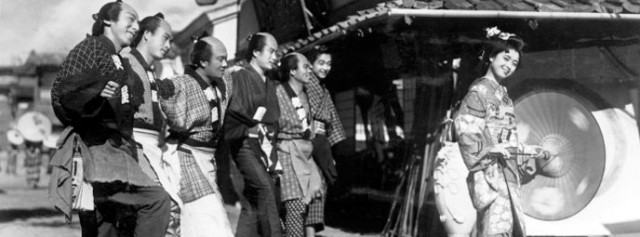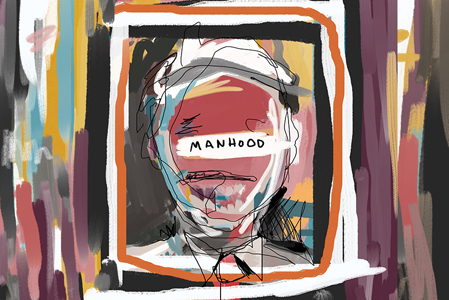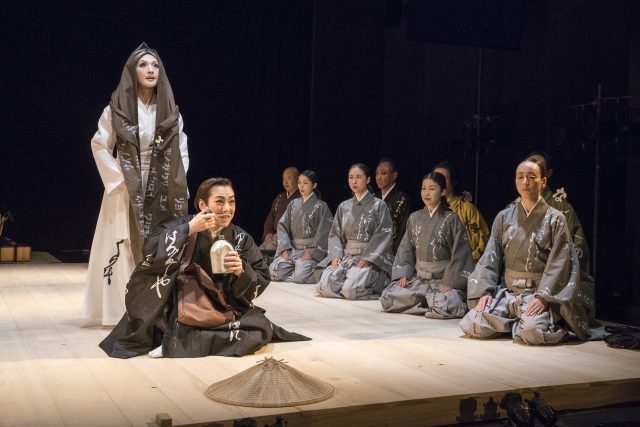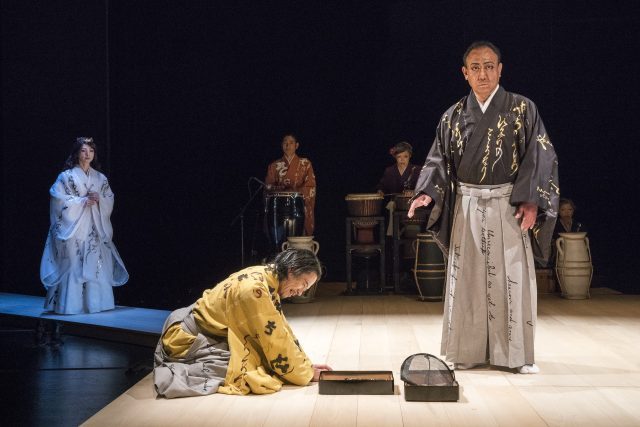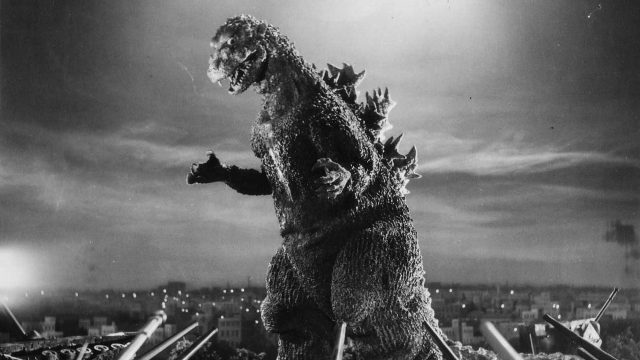
Godzilla emerges from the ocean after nuclear testing in classic monster movie
GODZILLA (Ishirō Honda, 1954)
Japan Society
333 East 47th St. at First Ave.
Friday, February 2, $13, 7:00
Directing Godzilla: Wednesday, February 21, $14, 6:30
212-715-1258
www.japansociety.org
 More than two dozen sequels, prequels, remakes, and reboots have not diluted in the slightest the grandeur of the original 1954 version of Godzilla, one of the greatest monster movies ever made. If you’ve only seen the feeble, reedited, Americanized Godzilla, King of the Monsters!, made two years later with Canadian-born actor Raymond Burr inserted as an American reporter, well, wipe that out of your head. On February 2, Japan Society is screening the real thing, the restored treasure as part of its Monthly Classics series; it will be followed on February 21 with “Directing Godzilla: The Life of Filmmaker Ishirō Honda,” a talk with Steve Ryfle, author of Ishirō Honda: A Life in Film, From Godzilla to Kurosawa, moderated by Film Forum repertory programming director Bruce Goldstein, whose Rialto Pictures released the film in theaters in 2004 and 2014, followed by a book signing and reception with many old Godzilla posters and memorabilia items on view.
More than two dozen sequels, prequels, remakes, and reboots have not diluted in the slightest the grandeur of the original 1954 version of Godzilla, one of the greatest monster movies ever made. If you’ve only seen the feeble, reedited, Americanized Godzilla, King of the Monsters!, made two years later with Canadian-born actor Raymond Burr inserted as an American reporter, well, wipe that out of your head. On February 2, Japan Society is screening the real thing, the restored treasure as part of its Monthly Classics series; it will be followed on February 21 with “Directing Godzilla: The Life of Filmmaker Ishirō Honda,” a talk with Steve Ryfle, author of Ishirō Honda: A Life in Film, From Godzilla to Kurosawa, moderated by Film Forum repertory programming director Bruce Goldstein, whose Rialto Pictures released the film in theaters in 2004 and 2014, followed by a book signing and reception with many old Godzilla posters and memorabilia items on view.
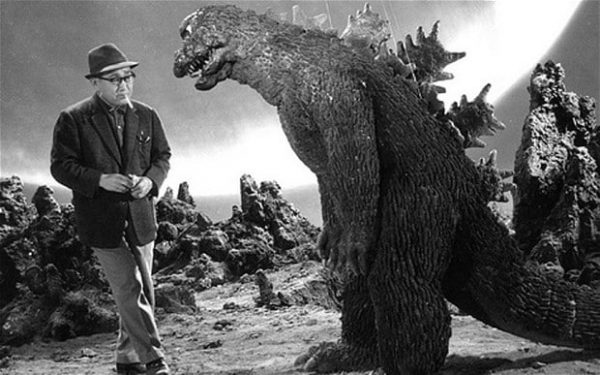
Ishirō Honda has a smoke with his atomic-gas-breathing monster on the set of Godzilla
The film was inspired by Eugène Lourié’s The Beast from 20,000 Fathoms and a real incident involving the Daigo Fukuryū Maru, a tuna-fishing boat that got hit by radioactive fallout in January 1954 from a U.S. test of a dry-fuel thermonuclear device in the Pacific Ocean. Writer-director Ishirō Honda and cowriter Takeo Murata expanded on Shigeru Kayama’s story, focusing on a giant dinosaur under the sea who comes back to life after H-bomb testing by the U.S. Standing 165 feet tall and able to breathe atomic gas, Godzilla — known as Gojira in Japanese, a combination of gorira, the Japanese word for gorilla, and kujira, which means whale — wreaks havoc on Japanese towns as he makes his way toward Tokyo. While the military and the government want to destroy the creature — who is played by Haruo Nakajima and Katsumi Tezuka in a monster suit, tramping over miniature houses, streets, cars, trains, and buildings using the suitmation technique (both men also make cameos outside the costume) — Dr. Yamane (Takashi Shimura) wants to study Godzilla to find out how the radiation only makes it stronger instead of destroying it. (Throughout, Godzilla is referred to as “it” and not “he,” perhaps because the creature is in part a representation of America and what it wrought in Hiroshima and Nagasaki.) “Godzilla was baptized in the fire of the H-bomb and survived. What could kill it now?” Dr. Yamane asks. Meanwhile, one of Dr. Yamane’s assistants, Dr. Serizawa (Akihiko Hirata), is working on a secret oxygen destroyer that he will show only to his fiancée, Yamane’s daughter, Emiko (Momoko Kōchi), who is having trouble telling Dr. Serizawa that she is actually in love with salvage ship captain Hideto Ogata (Akira Takarada). “Godzilla’s no different from the H-bomb still hanging over Japan’s head,” Ogata tells Dr. Yamane, who is none too pleased with his take on the situation. Through it all, the media risks everything to get the story.
Even for 1954, many of the special effects, photographed by Masao Tamai, are cheesy but fun, and composer Akira Ifukube’s fiercely dramatic score goes toe-to-toe with the monster. The Toho film is no mere monster movie but instead is filled with metaphors and references about WWII and the use of atomic bombs, examining it from political and socioeconomic vantage points while questioning the future of technological advances. “But what if your discovery is used for some horrible purpose?” Emiko asks Dr. Serizawa, who wears an eye patch, as if he can only see part of things. Godzilla could only have come from Japan, much like King Kong was purely an American creation produced by Hollywood; in fact, the two went at it in Honda’s 1962 film, King Kong vs. Godzilla. The next year, Akira Kurosawa would make I Live in Fear (Ikimono no kiroku), an intense psychological drama about the nuclear holocaust’s effects on one man, a factory owner played by Toshirô Mifune — who meets with a dentist portrayed by Kurosawa regular Shimura — a kind of companion piece to Godzilla. Honda, who served as an assistant director to Kurosawa on many films before making his own pictures, would go on to make such other sci-fi flicks as Rodan, The H-Man, Mothra, and Destroy All Monsters, but it was on Godzilla that he got everything right, capturing the fate of a nation in the aftermath of nuclear devastation while still managing to gain sympathy for the monster. It is also difficult to watch the film in 2018 without thinking of America’s current debate over illegal immigration and fear of the other, particularly when Godzilla approaches an electrified fence meant to keep him out, as well as the threat of nuclear war as President Trump battles Kim Jon Un on Twitter.
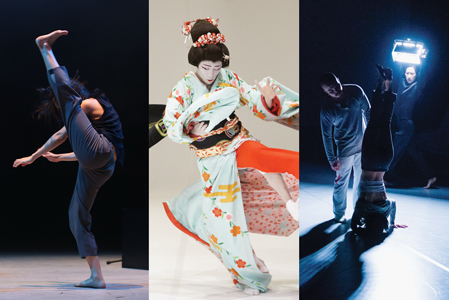
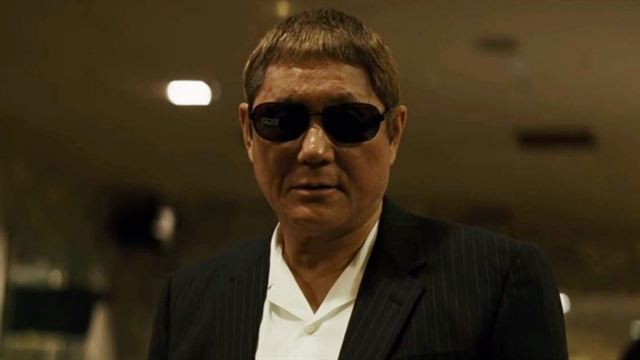
 The annual Japan Cuts series continues July 28 with the New York premiere of Takeshi Kitano’s Outrage: Coda, the finale in his yakuza series that began in 2010 with Outrage, followed two years later by Beyond Outrage. It’s not exactly the meeting of the five families in The Godfather when clan leaders get together as former stock trader Nomura (Ren Osugi) considers stepping down from his role as boss and selecting a replacement. Jockeying for various positions are the old school Nishino (Toshiyuki Nishida), the big, not too bright Hanada (Pierre Taki), the deeply pensive Nakata (Sansei Shiomi), and the sharp, cool Chang (Tokio Kaneda), who seems to have stepped right out of an episode of the original Hawaii Five-O. Detective Shigeta (Yutaka Matsushige) is on the case, watching it all very carefully, especially when round-faced Otomo (Kitano, who goes by the name Beat Takeshi as an actor) returns after a stint on Jeju Island in Korea.
The annual Japan Cuts series continues July 28 with the New York premiere of Takeshi Kitano’s Outrage: Coda, the finale in his yakuza series that began in 2010 with Outrage, followed two years later by Beyond Outrage. It’s not exactly the meeting of the five families in The Godfather when clan leaders get together as former stock trader Nomura (Ren Osugi) considers stepping down from his role as boss and selecting a replacement. Jockeying for various positions are the old school Nishino (Toshiyuki Nishida), the big, not too bright Hanada (Pierre Taki), the deeply pensive Nakata (Sansei Shiomi), and the sharp, cool Chang (Tokio Kaneda), who seems to have stepped right out of an episode of the original Hawaii Five-O. Detective Shigeta (Yutaka Matsushige) is on the case, watching it all very carefully, especially when round-faced Otomo (Kitano, who goes by the name Beat Takeshi as an actor) returns after a stint on Jeju Island in Korea.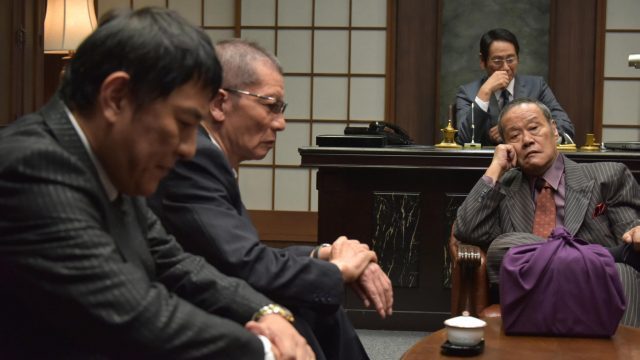

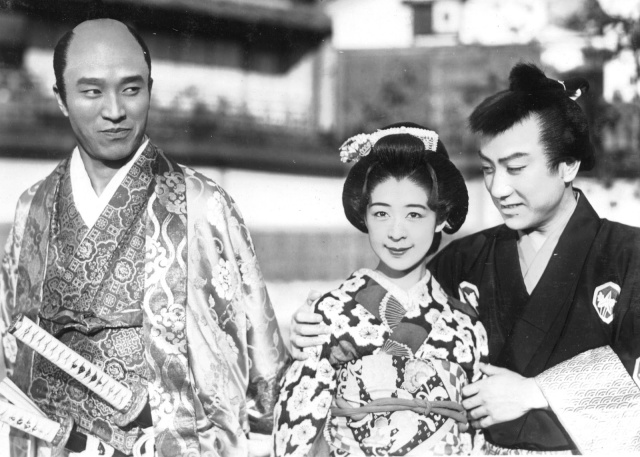
 In the 1930s, on the cusp of WWII, Japan was in the process of creating its own cinematic musical genre. One of the all-time classics is the wonderful Singing Lovebirds, a period romantic rectangle set in the days of the samurai. Oharu (Haruyo Ichikawa) is in love with handsome ronin Reisaburō (Chiezō Kataoka), but he is also being pursued by the wealthy and vain Otomi (Tomiko Hattori) and the merchant’s daughter, Fujio (Fujiko Fukamizu), who has been promised to him. Meanwhile, Lord Minezawa (jazz singer Dick Mine) has set his sights on Oharu and plans to get to her through her father, Kyōsai Shimura (Takashi Shimura), a former samurai who now paints umbrellas and spends all of his minuscule earnings collecting antiques. “It’s love at first sight for me with this beautiful young woman,” Lord Minezawa sings about Oharu before telling his underlings, “Someone, go buy her for me.” But Oharu’s love is not for sale. Directed by Masahiro Makino, the son of Japanese film pioneer Shōzō Makino, Singing Lovebirds is utterly charming from start to finish, primarily because it knows exactly what it is and doesn’t try to be anything else, throwing in a few sly self-references for good measure.
In the 1930s, on the cusp of WWII, Japan was in the process of creating its own cinematic musical genre. One of the all-time classics is the wonderful Singing Lovebirds, a period romantic rectangle set in the days of the samurai. Oharu (Haruyo Ichikawa) is in love with handsome ronin Reisaburō (Chiezō Kataoka), but he is also being pursued by the wealthy and vain Otomi (Tomiko Hattori) and the merchant’s daughter, Fujio (Fujiko Fukamizu), who has been promised to him. Meanwhile, Lord Minezawa (jazz singer Dick Mine) has set his sights on Oharu and plans to get to her through her father, Kyōsai Shimura (Takashi Shimura), a former samurai who now paints umbrellas and spends all of his minuscule earnings collecting antiques. “It’s love at first sight for me with this beautiful young woman,” Lord Minezawa sings about Oharu before telling his underlings, “Someone, go buy her for me.” But Oharu’s love is not for sale. Directed by Masahiro Makino, the son of Japanese film pioneer Shōzō Makino, Singing Lovebirds is utterly charming from start to finish, primarily because it knows exactly what it is and doesn’t try to be anything else, throwing in a few sly self-references for good measure.